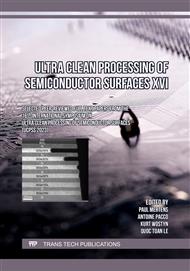p.74
p.83
p.91
p.99
p.105
p.111
p.117
p.123
p.131
Observation of Capillary Condensation and Pattern Bending Phenomena in Si Nanopillars Using In Situ TEM
Abstract:
Capillary condensation, a ubiquitous phenomenon involving the heterogeneous nucleation of liquid droplets, has significant implications in various industrial, biological, and atmospheric processes. Strong capillary forces induced by highly curved menisci of condensates can have potentially significant impact on the structural integrity and functionality of nanodevices. While the influence of surface properties on the nucleation and growth of water droplets has been extensively studied at microscale, our understanding of water condensation at the nanoscale remains limited due to experimental challenges in imaging liquids at nanometer scales. In this study, we employ in situ liquid phase TEM imaging and for the first time present real-time observations of water condensation dynamics on arrays of vertical silicon (Si) nanopillars. Experimental and simulation results show that nucleation of water droplets occurs at the edges of the nanopillars and substrate, followed by the growth of an interfacial layer resembling a corona around the nanopillars. Subsequently, the formation of bridges between adjacent growing coronas leads to the development of symmetric and asymmetric bridged nanopillar geometries. Importantly, we find that the formation of bridges can induce bending and collapse of the nanopillars, depending on their aspect ratios. Overall, this study provides valuable insights into the nanoscale dynamics of capillary condensation and paves the way for advanced engineering applications and optimization of various technological processes.
Info:
Periodical:
Pages:
105-110
Citation:
Online since:
August 2023
Authors:
Price:
Сopyright:
© 2023 Trans Tech Publications Ltd. All Rights Reserved
Share:
Citation:


